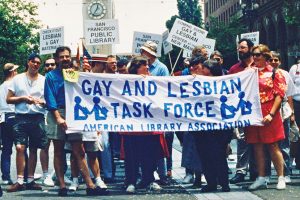
“The most destructive thing we can do is silence trans stories,” says Becky Hass, programming and outreach manager at Maryland’s Anne Arundel County Public Library (AACPL), who identifies as a trans-ally librarian. “Sharing stories of not only surviving, but thriving, beautiful trans lives becomes a literal gift of life in our communities.”
In “Serving the Transgender Community: It’s More Than Just Bathrooms!,” an American Library Association (ALA) Virtual program sponsored by the ALA Rainbow Round Table and moderated by Deb Sica, deputy county librarian at Alameda County, panelists discussed things libraries can do to serve the needs of the transgender community. Transgender and nonbinary members of the panel shared their own experiences as library users and workers.
When it comes to creating space for trans perspectives, a good entry point is engaging in partnerships with local groups such as gay-straight alliances, transgender-specific organizations, and others.
Visibility is important all year long, says Meg Metcalf, women, gender, and LGBTQ+ studies librarian at the Library of Congress, who is nonbinary femme. “There are ways you can invest in the trans community: pay someone to do a storytime, pay someone to speak on a panel.” Have programs outside of Pride month. “Please do not tell your LGBTQ librarians to just have their programs in June,” they urge.
Having transgender staff members or volunteers also provides visibility. “Knowing there’s another trans person in your library is important,” says Robert Taylor, a trans person who is acquisitions and cataloging librarian at Valdosta State University in Georgia. “That way if a student needs help, they know that there’s someone who’s safe to go to.”
Programs that center LGBTQ history and establish that transgender people have existed throughout history help provide context for trans rights movements today. Hass notes that AACPL partnered with the organization Annapolis Pride to host an event covering more than 300 years of LGBTQ history in the area. “Digging into the past and seeing what comes up is a great way to establish the rootedness of what we’re talking about,” Sica adds.
There are also subtle ways to show support: Something as small as a pronoun name tag can help people feel welcome. And if you include a book by a transgender author in a book display, “trust me, we notice,” says Taylor.
Don’ts
By avoiding particular actions, you can avoid making transgender people feel singled out or unwelcome. “Don’t ask invasive questions,” says Alex*, a librarian who is a transgender woman. Avoid asking about “anything that you wouldn’t want asked of yourself.”
And “do your own research,” says Metcalf. “Don’t just lean on your LGBTQ coworkers” as your only source for learning about queer identities and issues.
Rooting out ingrained biases is also key. Requiring gender on a library card application, or making it difficult to change old information, is a barrier to service. And when it comes to collecting information generally, “be aware of your language on surveys,” Taylor says. Don’t offer only binary gender choices.
Pronouns
While normalizing pronouns as part of introductions can go a long way, Alex suggests that it’s important to use gender-neutral terms when referring to patrons for the first time.
Transgender allies need to be prepared to help educate others on using the correct pronouns. “I think most people are operating under the assumption that there’s no consequence for misgendering people,” Metcalf says. And Taylor notes that they themselves often don’t feel comfortable pressuring people who are unwilling to use they/them pronouns when referring to them. Still, they note, “I had an ally who was correcting people without me knowing. … Do not be afraid to lean on your allies.”
Mistakes will happen, so “don’t obsess over your mistakes,” Taylor suggests. “If you misgender someone and you get corrected, just apologize quickly and move on and do better in the future. … Don’t put us in another awkward spot” by overexplaining or repeatedly bringing up your mistake.
A respectful work environment
When Alex started her job, her old name was still on some of her documents. “Just be there and be supporting and if they say they have a different name on different documents, work around that in complete confidence,” she says, “just like any other HR situation.”
And, of course, gender-neutral bathrooms are still an essential service. “We’re just hoping that the bathroom is a given at this point,” says Sica. “We know it’s not, but we’re going to say it’s a basic human right and it needs to be upheld.” Still, given the opportunity to magically fix one issue facing transgender people, “I’ve got to say bathrooms,” Taylor says. “Do you know how many conferences I have gone to where there is nowhere for me to go?”
Alex urged libraries to think critically about their urge to play to “both sides” when addressing transgender issues. “I know we want to give equal presentation to ideas and make sure everyone is included, but when science is behind you and everything like that, I don’t think we should be giving a place to deny trans people’s existence,” she says. “We should have those books available, but we should be having a lot more programs where trans people are included.”
*Name changed at source’s request.


